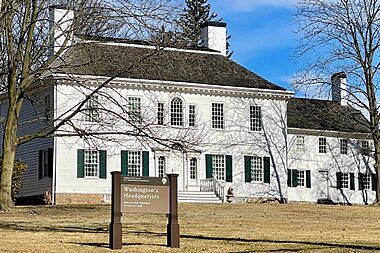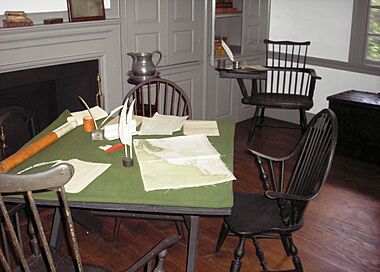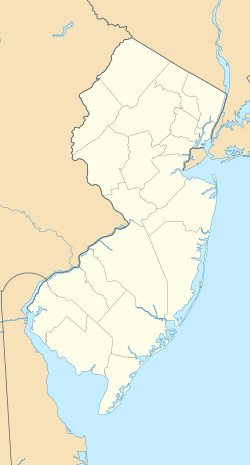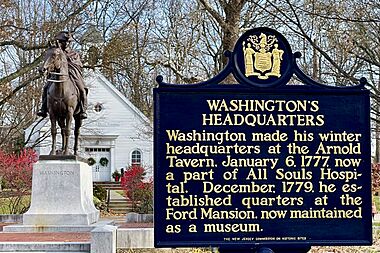Ford Mansion facts for kids
Quick facts for kids |
|
|
Ford Mansion
|
|
|
U.S. Historic district
Contributing property |
|

Ford Mansion, George Washington's Revolutionary War headquarters from December 1779 to June 1780
|
|
| Location | 30 Washington Place Morristown, New Jersey, U.S. |
|---|---|
| Built | 1774 |
| Built by | Jacob Ford, Jr. |
| Architectural style | Georgian style |
| Part of | Morristown National Historical Park (ID66000053) |
| Designated CP | October 15, 1966 |
The Ford Mansion, also known as Washington's Headquarters, is a historic house in Morristown, New Jersey. It was built in 1774 and is famous for being where General George Washington stayed during the American Revolutionary War. He used it as his main office from December 1779 to June 1780.
The house was built in the Georgian style by Jacob Ford Jr. Today, the National Park Service owns it. It became part of the National Register of Historic Places on October 15, 1966, as part of the Morristown National Historical Park.
Contents
Exploring the Ford Mansion's Design
The Ford Mansion looks like a classic Georgian-style house from the outside. However, if you look closely at the kitchen and its wooden frame, you can see some Dutch influences. The outside walls of the Ford Mansion were made of painted boards. These boards were carefully painted and scored to look like fancy stone walls, with special corner blocks called quoins.
What Makes the Mansion Special?
Above the main door, there is a beautiful Palladian window, which is a large window divided into three parts. The house also has a stylish cornice, which is a decorative molding at the top of the walls. These fancy architectural details were not just for looks. They were meant to show how wealthy and important the Ford family was.
Inside the Mansion
The main part of the house was designed with rooms that mirrored each other on both sides of the entrance hall. For example, the office was directly across from the library, and the parlor was across from the dining room. Upstairs, the bedrooms were also arranged symmetrically around the hallway. The servants' area was located on the east side, close to the kitchen and pantry. The large main hall and the parlor are what truly make this house a mansion. Instead of using bricks, which were common then, the Ford Mansion used painted wooden boards for its exterior.
Why Morristown Was Important
George Washington and the Continental Army chose Morristown for their winter camp because of its good location. Washington liked that the area had strong defenses, important roads for communication, and easy access to necessary supplies. The Ford family, who owned the mansion, also had businesses nearby. They ran iron mines, forges, a gristmill, a hemp-mill, and a gunpowder mill. These businesses were very helpful for getting resources for the army.
Life in Morristown During the War
The town of Morristown had about 250 residents and 70 buildings. In 1777, many high-ranking army officers rented houses there. However, a smallpox outbreak spread through the town from the soldiers. This made some townspeople feel a bit unhappy with Washington's troops when they returned in 1779. Washington's main army was stationed at Jockey Hollow, which was about five miles south of the Ford Mansion.
The Ford Family's Story
The Ford Mansion was first owned by Colonel Jacob Ford Jr. He received the land from his father in 1762, the same year he married Theodosia Johnes. Before the war, Jacob Jr. and his father owned an iron forge in Whippany, New Jersey. Ford built the house just south of the Whippany River, making it easy to get to his work.
Jacob Ford Jr.'s Role and Legacy
Jacob Ford Jr. was the commander of the Eastern Battalion of the Morris County Militia. Sadly, he passed away from pneumonia on January 11, 1777, right there in the mansion. Thirty-five Delaware troops were present when he died.
Ford and his soldiers had captured a bronze six-pound cannon from the British Army on January 3, 1777, during their victory at Princeton, New Jersey. Cannons and weapons were in short supply for the American army. The victory at Princeton not only made the Continental Army feel more hopeful, but it also gave them much-needed weapons. The cannon they captured is now on display at the museum on the Ford Mansion property, along with other cannons from that time.
The Ford Mansion During the War

After Jacob Ford Jr. passed away, his wife, Mrs. Theodosia Ford, became the owner of the mansion. She was very strong and managed to keep the family, the farm, and their businesses successful.
Before Washington arrived, the house had seen some difficult times for the Ford family. In 1777, it was rented to Continental Army troops who developed smallpox. When Washington arrived in 1779, he asked Mrs. Ford for permission to stay in the mansion and paid her rent. General Washington, his wife Martha Washington, five of his military assistants (called aides-de-camp), and 18 servants all stayed in the mansion. Mrs. Ford and her four children used two of the four bedrooms downstairs and kept the kitchen for their own use.
Washington's Time as Commander-in-Chief

Washington arrived at the Ford Mansion in December 1779. The location was perfect for him because the American capital was in Philadelphia, and the British Army's main base was in Manhattan. This allowed Washington to keep a close watch on the British and easily send letters to the Continental Congress.
During his stay at the Ford Mansion, Washington wrote many letters to Congress. He explained the difficult situation his troops were in, especially during the harsh winter. His personal workspace was in a private study on the first floor of the house. Washington's aides-de-camp, including Alexander Hamilton, Robert H. Harrison, Tench Tilghman, Richard Meade, and James McHenry, worked in the parlor, which became the military office.
One important record of Washington's stay is a letter from Richard Meade to Mrs. Ford, dated July 26, 1780. It confirmed that Washington stayed at the mansion from December 1, 1779, to June 23, 1780. It also noted that he used two rooms downstairs, all of the upstairs, the kitchen, cellar, and stable. The letter also mentioned that the stable was built and two upstairs rooms were finished at the public's expense. A well that was previously unusable was also repaired.
Preserving History: The Ford Mansion Today
The Washington Association of New Jersey was created to help protect the Ford Mansion and its history in Morristown. This group bought the mansion in 1873 and started working to restore it. A small house for a caretaker was built nearby in 1886. In 1933, the mansion and its grounds were given to the National Park Service, which continues to care for this important historical site.
See also
- New Jersey in the American Revolution
- List of Washington's Headquarters during the Revolutionary War
- List of museums in New Jersey
- List of the oldest buildings in New Jersey
- List of historic sites preserved along Rochambeau's route







